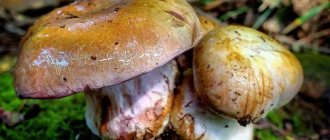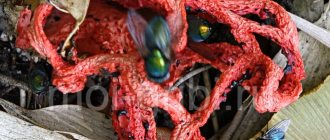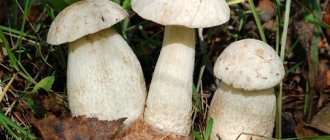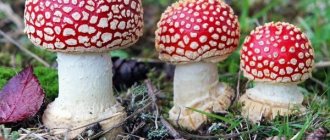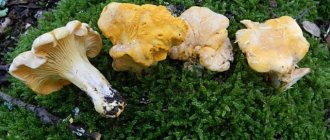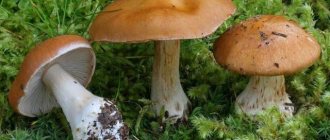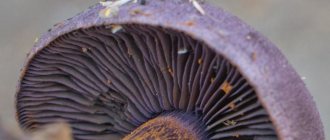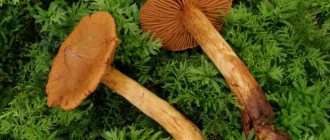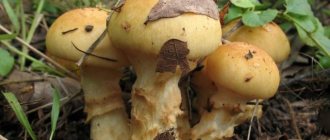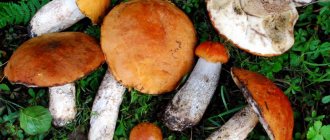The purple web spider (Cortinarius violaceus) belongs to the spider web family and is quite rare. It is listed in the Red Book of Mushrooms in the Russian Federation. The mushroom is edible and can be eaten, but pregnant and lactating women, young children and people with serious gastrointestinal problems or allergies should not do this. The pulp of this mushroom contains useful substances such as vitamin B and zinc, which is why it is used in the process of creating antibiotics and drugs that fight fungus. It is also used in folk medicine to restore the health of the heart and blood vessels and lower sugar.
Description of the mushroom
Violet marshweed or lilac webweed - these are the names you can hear among amateurs and scientists. Latin names and synonyms: Cortinarius violaceus, Agaricus violaceus and Gomphos violaceus. The mushroom belongs to the genus Cobwebs of the Cobweb family.
The cap grows on average up to 10 cm in diameter, the largest specimens are 15 cm. Convex, cushion-shaped as they grow, and becomes prostrate in older people. With age, the edge becomes wavy. The surface is purple, felt-like with scales.
The hymenophore (bottom of the cap) consists of plates that grow to the stem with a tooth. They are located sparsely, rather wide, purple. The spores are brown, slightly rusty in color.
The pulp does not change when cut, has a purple or bluish color, often grayish. There is no smell, sometimes there is a nutty taste.
The leg can reach 12 cm in height, and its thickness is no more than 2 cm. The top is covered with scales, expanding downwards in the form of a tuber. The color is purple, brownish, the flesh is fibrous.
The mushroom is listed in the Red Book of Russia. It is found in the European part and the Far East, in Siberia, the Tomsk and Chelyabinsk regions, and the Krasnoyarsk Territory. It is considered a rare species and has not been fully studied.
A little history
British explorer Samuel Frederick Gray was the first to describe the violet web mushroom. He studied not only botany, but also pharmacology and chemistry.
Amethyst varnish
Amethyst varnish, or in other words, lilac varnish, belongs to the lamellar mushrooms and attracts mushroom pickers and mycologists with its bright lilac color. Belongs to the class Agaricomycetes and the Hydnangiaceae family.
Appearance
| Hats | They are round and can reach a diameter of 2 to 6 cm. They have a bright purple color, similar to amethyst. The upper parts are hemispherical in shape, but become more flat as they mature. As the caps mature, they tend to change shades: small individuals are distinguished by pleasant purple flowers, while adults are less beautiful, as the bright color disappears. |
| Legs | Straight, quite thick. They can reach a height of 12 to 20 cm. The legs also fade and take on whitish shades. |
| Records | The plates can be called delicate, very small and sparsely located. They tend to gradually turn into legs. |
| Spore powder | Has whitish or light purple shades. |
| Places and times of growth | Can be found in Europe, Central and South America, North Africa, Asia and eastern North America. They prefer forests and moist soil, and especially places near mosses and spruce forests. Most often found in mixed or deciduous forests. They ripen throughout the entire summer period, ending at the end of September. They grow either alone or in the form of small rings, in which specimens can sometimes grow together. |
Edibility
Amethyst or purple lacquer is an edible variety. The entire fruiting bodies are usually used for food. The cap is more pleasant to the taste, as it has a soft, pleasant consistency, sparsely located delicate plates and a bright mushroom smell.
Many experienced mushroom pickers believe that it is better to mix amethyst varnish with other more familiar edible varieties when preparing traditional dishes. The pulp can be used in preparing soup or a second course (stewed, fried mushrooms and meat with any side dish). It is not worth using for food without specimens of another species, since the taste of amethyst varnish is unremarkable.
Similar species
The edibility and toxicity of amethyst varnish depends on how and where it grew:
- If the summer period was dry, the fruits may quickly fade. In this case, the individuals have the appearance of pink lacquer, which is edible. Both types can be used in preparing different dishes.
- Normal development conditions make the purple fruit look like purple spider webs, which have a similar color. However, the fruiting body of the spider web is larger and heavier.
- The edible amethyst varnish can be confused with mycena pure, which is a poisonous variety that has a similar appearance and grows close to its harmless companions. Distinctive characteristic: pure mycena has pulp with the smell of radish, but this is impossible to observe in the varnish.
An interesting feature of lacquer is its ability to retain particles of arsenic, a heavy metal that is dangerous to human health because it can develop cancer. You cannot pick up varnish or any other mushrooms near highways or any industrial facilities.
The varnish has a beautiful purple hue, atypical for a fruiting body. The bright purple cap stands out from other plants or grass.
Thus, many varieties of mushrooms have a beautiful purple color. You must be extremely careful and careful when picking mushrooms, because you can stumble upon both edible and tasty, and dangerous and poisonous specimens of the mushroom kingdom.
What do false doubles look like?
There are no real twins of the purple marshweed, there are slightly similar ones, but they have obvious distinctive features.
| Name | hat | Hymenophore | Danger |
| Lilac web spider | Purple, cushion-shaped | Lamellar, in the color of the cap, rusty spores | Conditionally edible |
| Row purple | Bright purple, fades later, becomes depressed with age | The plates are purple, later turn pale, the spores are white-pink | Conditionally edible |
| Amethyst lacquer | Purple, fades, becomes flat with age | With age, whitish-powdery, white spores | Edible |
| Entoloma (Entoloma porphyrophaeum) | Lilac-brown, then brown, flat-convex | Whitish, creamy, pink with age, pink spores | Inedible, properties not fully studied, possibly dangerous |
Mushrooms are also blue, but of a different shade; it is difficult to call them doubles. In addition, almost all varieties of entoloma are considered, if not poisonous, then inedible, and therefore it is not recommended to collect them.
Interesting facts about purple web spiders
Not all mushroom pickers have heard of the purple web spider. This is partly due to the rarity of the Red Book mushroom. But another reason is that the bright colors of the marsh plant make many people mistake it for a poisonous mushroom and avoid it.
Purple marsh grass is used not only in cooking and medicine, but also in industry. Environmentally friendly paints are made using marshland. The natural dye in the mushroom pulp is completely safe, but is highly durable.
The purple mushroom is called cobweb mushroom because the young fruiting bodies on the underside of the cap are covered with a continuous dense cobweb. With age, this blanket breaks and disappears, but even in adult marsh-dwellers you can sometimes notice its remains on the edges of the cap and on the stem.
Evaluation of taste qualities, medicinal properties, benefits and possible harm
Lilac web spider does not have the highest taste, but it can be boiled and fried, as well as salted and pickled. It is not recommended to collect the mushroom, since it is rare and you cannot collect a large quantity; it grows mostly solitary and does not appear every year.
Like most mushrooms, purple cobweb contains B vitamins, zinc, copper, and also contains manganese, the smell of which many smell when cut.
There is information that it is used in pharmacology for the production of antifungals and antibiotics. Helps reduce glucose levels, has anti-inflammatory properties, supports the functioning of the immune system.
IMPORTANT! Any mushrooms should not be eaten by children under 3 years of age, pregnant and lactating women, as well as during periods of exacerbation of chronic diseases of the gastrointestinal tract, liver and kidneys. People predisposed to allergies should consume such products with caution.
Habitat of growth and timing of collection
The web spider is popularly called the marsh plant. Why this name? Not hard to guess. It loves to grow in swampy places, lowlands, where there is a lot of moisture, near birches, pines and spruce trees (Figure 5).
Note: Despite its bright color, this mushroom is not so easy to spot in the forest because it hides under leaves and moss.
Cobwebs can rarely be found growing alone; they mostly grow in families of up to 20 pieces. So, if you find yourself in such company, you can easily save up for a delicious lunch. You can collect marsh grass from the last summer month of August to October.
Cooking recipes
Most lovers of quiet hunting, who have had time to taste this forest fruit, believe that it does not perform well in hot dishes, but in pickling or marinade it is just what is needed, and besides, the color turns out magical, fabulous. Cooking it is interesting and a little scary. It belongs to class 4.
Primary processing
After the mushroom is delivered home, it should be thoroughly cleaned of forest debris, washed and the film removed from the top.
Purple marsh grass cannot be soaked, since it has neither a bitter taste nor milky juice; it is easy to prepare.
Cooking
Add salt to the water and boil the mushrooms in it for an hour. After this, you can proceed to further actions. At the end of cooking, the broth is drained. Many mushroom pickers recommend removing the liquid during the process and pouring a new one. Both times the water will turn out a strong purple color.
Pickling
A short and quick recipe.
For pickling you will need for 1 kg of fruit:
- salt – 2 tbsp. l.;
- sugar – 2 tbsp. l.;
- vinegar - 2 tbsp. l.;
- allspice peas – 5 pcs.;
- laurel leaf – 1 pc.;
- garlic – 5 cloves.
If you wish, you can use your own ingredients or remove the garlic (who doesn’t like it); the main ingredients remain salt, sugar and vinegar.
All these seasonings and spices are added to 2 liters of water and put on fire; after boiling, you need to immerse the prepared and boiled mushrooms there, then keep on the fire for another 20 minutes.
Next, place the fruits in jars and add marinade to the top. Sterilize for 15 minutes. Roll up the lids and let cool. Once cooled, store in a cool, dark place.
Pickling
After completing the 40-minute boiling, remove the mushrooms from the water, arrange them in layers in a prepared container, sprinkling them with salt.
In this case, if desired, you can add finely chopped garlic, dill, currant or horseradish leaves, laurel, peppercorns or other seasonings.
Cover the top with a clean cloth and press down with pressure. After a day, juice will be released, in which the cobweb will continue to salt. You can try it after 40 days, and during this period regularly check the covering material, rinse it or replace it with a new one if necessary.
At the end of the salting, place the product in jars, fill to the top with brine and place in a cool place or in the refrigerator.
Where does it grow
The mushroom usually grows in Russia and Europe. It can be found in both mixed and deciduous forests. It can also be found in cold regions, such as the Murmansk region. It does not like open spaces and usually grows in swampy areas. Most often you can find one or several mushrooms, less often you can find a whole colony. Loves the area under coniferous trees such as spruce and moss beds, in which you can easily hide from prying eyes.
You can find mushrooms from August until the end of October.
